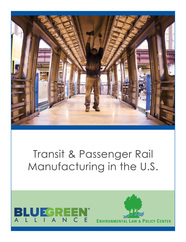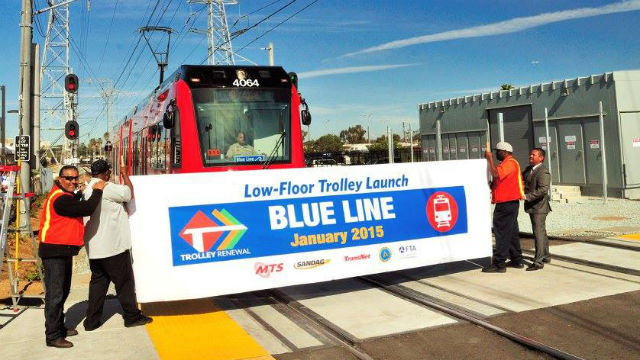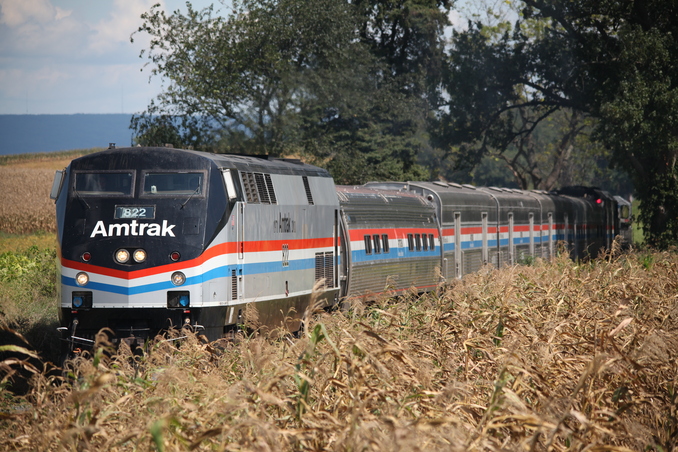Happening Now
Hotline #896
January 30, 2015
The state of Indiana and Amtrak announced they have reached an agreement that will keep the Hoosier State running until April 1, beating an end-of-January deadline by a day.
Amtrak’s 60-day contract extension with the Indiana Department of Transportation (INDOT) will give all sides more space to reach an agreement on a long-term contract. Early reports indicate that Amtrak will continue to manage operations of the Indianapolis – Chicago train, with INDOT contracting out portions of the service to other companies.
Amtrak was able to maintain service along most of the Northeast Corridor through a blizzard which threatened to slam the entire East Coast. Ultimately, the worst of the blizzard missed most of the Mid Atlantic, saving the majority of the snowfall for New England.
Trains continued to run along the NEC on Monday evening and into Tuesday between Washington, D.C. and New York City. As a safety precaution, Amtrak suspended service on the Empire Corridor and the Albany branch of the NEC early Tuesday, along with most New England service. Service returned to normal by Wednesday morning.
Air travelers were not so lucky, with more than 4,700 flights canceled at La Guardia, JFK International, and Newark Airport alone.
 A study released by the ELPC and the Blue Green Alliance found that more than 750 companies in at least 39 states manufacture components for passenger rail and transit rail today, supporting 90,000 manufacturing jobs today.
A study released by the ELPC and the Blue Green Alliance found that more than 750 companies in at least 39 states manufacture components for passenger rail and transit rail today, supporting 90,000 manufacturing jobs today.
The report focused on the Mid Atlantic and the Midwest, so the supply chain and job numbers are certainly lower than reality. But this report gives our members a tool they can use to show policy makers the economic power of investment in transit and trains, and to advocate for increased funding for modern passenger rail.
Other highlights from the report include:
- 212 companies in 32 states manufacture passenger rail cars and locomotives or major components and systems for these vehicles.
- Focusing on just two rail manufacturing regions — the Midwest and the Mid-Atlantic — we find more than 540 additional companies manufacturing sub-components, materials, track and infrastructure, as well as providing repair and re-manufacturing to the industry in these states. The nationwide total is certainly much larger.
- These manufacturers are located in virtually every state, in diverse industries, and often in communities far from the transit and rail systems themselves.
- The U.S. rail manufacturing industry as a whole supports 90,000 jobs today.
- Passenger rail and transit rail manufacturing growth helps strengthen a broader manufacturing recovery — creating and sustaining manufacturing jobs in railcar and locomotive assembly, as well as across a wide range of American industry, ranging from steel smelting to fabric design.
The report breaks the job numbers out by Congressional District for several Midwest and Mid Atlantic states. Find your state and congressional district, and then pass this along to your representative to educate them on how many jobs investing in rail can create! Better yet, call and ask to meet with your member or their district office staff in your local area!
As the 114th Congress gets back up to speed, several competing plans to address the nation’s infrastructure crisis are jostling for political position and public attention.
Senators Bernie Sanders (I-VT) and Barbara Mikulski led with the most ambitious legislation—a five-year, $1 trillion infrastructure plan that would invest $15 billion per year in modern passenger rail.
“My legislation puts 13 million people to work repairing the backlog of infrastructure projects all across this country,” said Senator Sanders. “These projects require equipment, supplies and services, and the hard-earned salaries from these jobs will be spent in countless restaurants, shops and other local businesses. It’s no surprise that groups across the political spectrum—from organized labor to the U.S. Chamber of Commerce—agree that investing in infrastructure will pay dividends for future generations.”
The biggest obstacle for this bill is that it does not identify a way to pay for it. Several other Senators have pushed alternate proposals that focus on the question—most notably Sens. Rand Paul (R-KY) and Barbara Boxer (D-CA). The bipartisan duo is looking to raise revenue through a corporate tax holiday that would encourage repatriation of offshore earnings. By taxing repatriated foreign earnings at 6.5%, the proposal would providing a one-time infusion of revenue to the Highway Trust Fund.
“This would mean no new taxes, but more revenue, and it's a solution that should win support from both political parties,” argued Senator Paul.
Former-governor Ed Rendell, currently head of the Blue Green Alliance, pushed back against one-time fixes, telling Senators this week that the gas tax remains the surest and quickest way to secure a stable source of infrastructure investment.
“It is inescapable,” said Rendell. “Do your jobs. Raise the gas tax.”
The Center for American Progress (CAP) published a new infrastructure report that shows 40 percent of all National Highway System (NHS) miles do not “generate sufficient user fee revenues to cover their long-term maintenance costs—even when initial construction and inflation costs are removed from the analysis.”
CAP undertook the project to dispel the myth that roads pay for themselves, an argument anti-train forces push in an effort to undercut the case for investing in passenger rail and transit. The group points out that highway advocates in 30 states have successfully enacted provisions that prohibit using revenues from the gas tax on transit, even though general funds inevitably end up covering road costs.
“Every type of transportation requires public subsidy,” said Kevin DeGood, Director of Infrastructure Policy at CAP. “Just because a portion of funding comes from highway drivers does not mean building more highways is the best solution—especially in metropolitan regions. Yet in many states, the source of money dictates how that money must be spent. Rather than predetermining what must be built, we should encourage planners to make investment decisions based on what will provide the most benefit, rather than where the money comes from.”
A decision by Illinois’ recently-elected Governor Bruce Rauner (R) to suspend all projects while they are reviewed by his administration has worried supporters of a project that will restore train service on the Rockford – Chicago line.
"Major construction projects at IDOT, including the proposed Rockford service, are on pause and under review” states a report issued January 29 by the Illinois Department of Transportation.
Regional leaders are rallying around the train, which was slated to begin operations in 2015, saying improving mobility is a critical component of stimulating development and job-creation.
“I would argue that anything you can do to improve transportation infrastructure economically benefits the Rockford region and the state,” state Senator Steve Stadelman told local reporters. “So it’s something that needs to go ahead no matter what our financial situation is.”
Local passengers have joined in calling for the line to go forward.
“I think it would be advancement even economically for the city to make sure that all lines running to Chicago are open that there are different options for people to make it there and back,” said Rockton passenger Kevin Pullam, who travels to Chicago for business several times a month.
A January 28 hearing on rail safety convened by the Senate Committee on Commerce, Science & Transportation highlighted serious concerns about the timeline and method for introducing Positive Train Control signaling systems on the U.S. rail network.
PTC is a life-saving technology that monitors and controls train movements, reducing the risk of derailment and collisions. The 2008 passenger rail authorization established a requirement that PTC be installed on U.S. rail corridors that carry passengers or dangerous chemicals by December 31, 2015.
Union Pacific’s President & CEO Lance Fritz told the Senate committee that installing PTC will cost freight railroads billions of dollars, and that technological restraints will prevent railroads from meeting the December 2015 deadline.
“Right now the heavy lift on PTC is the fact that it's unproven technology,” Fritz told senators. “We're installing it as we invent it.”
State rail officials also voiced concerned, saying the costs are being unfairly shifted onto passenger operations by freight railroads looking to avoid paying for PTC. Michelle Teel, Multimodal Director at the Missouri Department of Transportation, told the Committee in her testimony that the state is looking at roughly a 200% annual increase in operating costs if the Kansas City Terminal Railway is allowed to shift PTC costs to the public:
“As KCT views the law through FRA interpretation and subsequent regulation, the only requirement for implementing PTC in the terminal is the six passenger train movements per day, not the 250 freight movements through this dense population center. Amtrak explained in the letter the estimated total cost for installation in KCT will be about $32 million. The letter states Missouri’s share for the state sponsored Missouri River Runner passenger rail service (contracted through Amtrak) is approximately $20 million and about $2 million a year for maintenance in KCT alone. To give some scale to this - Missouri's cost to fund the Missouri River Runner passenger rail between Kansas City and St. Louis is approximately $9 million per year. The service operates on the KCT for only about 6 miles of the entire 250 mile route.
“MoDOT believes PTC helps improve rail safety. However, requiring MoDOT and Amtrak to bear the cost of the entire PTC system in the terminals - considering the volume of hazardous materials and other commodities in these dense population areas - does not seem to comply with the intent of the law. While this issue impacts Missouri the most severely, Illinois and California are also impacted by this FRA interpretation.”
Missouri Senator Claire McCaskill responded with a strong defense of the state’s passenger service, saying PTC must not stand in the way of a service that is so important to so many communities.
“We have tens upon thousands of people that rely on the train in Missouri and it is unacceptable that we would interrupt passenger service over [the positive train control] issue,” McCaskill said. “I would like there to be a more realistic target for the [positive train control] deadline which gives us time to try to work this out among the various players. I hope we can get quick action on the PTC delay bill in order to give some more certainty to the environment in Missouri so we can make sure that we have and continue to have passenger rail service.”
The French operating company SNCF has expressed interest in submitting a bid to operate a high-performance rail corridor that would connect Dallas, Arlington, Fort Worth, Austin and San Antonio.
Media attention has been focused on the Dallas – Houston high-speed rail line currently being developed privately by the Texas Central Railway in conjunction with Japanese railroad company JR East. Investors have committed to providing $10 billion in funding, which would see the 220 mph service up-and-running by 2021
SNCF sees opportunities in other parts of the state, and the company traveled to Fort Worth to speak with the Texas high-speed rail commission about potential partnerships.
“We’re here to listen, learn and evaluate,” Alain Leray, President and CEO of SNCF America Inc., told reporters.
The Texas Department of Transportation is currently doing planning and environmental work on the corridor, and is expected to release its recommendations for the route in 2015.
News in Brief
— Chicago's Regional Transportation Authority (RTA) released a report that warns investment is failing to keep up with demand, with the authority facing $36 billion in capital needs over the next 10 years.
Key elements that are at risk include the acquisition of new equipment and infrastructure state of good repair. The RTA officials are calling for greater federal and state investment to help maintain transportation infrastructure.

—San Diego’s Metropolitan Transit System launched new low-floor trolley cars January 27, improving efficiency on the city’s Blue Line.
"This is a significant milestone for our region’s trolley network," said MTS Chairman Harry Mathis. "The low-floor design will make our entire transit system more efficient. Additionally, upgrades at Blue Line stations — such as 8th Street and 24th Street — will vastly improve bus and trolley connections."
—Officials representing the Miami Intermodal Center said this week that the opening of the $2 billion transit hub will be delayed. The revised schedule outlines a phased opening, with the Tri-Rail station opening this spring as planned. The Amtrak station has been pushed back to summer 2016. The delay will accommodate construction work and allow local agencies to resolve a jurisdictional dispute over the station.
Passenger Advisory
—Amtrak California is promoting a special offer where the purchase of one adult full fare ticket gets 50% off a companion fare. Tickets must be purchased before February 25, 2015. Use promo code V613 to receive discount. Travel date restrictions apply. Visit AmtrakCalifornia.com for more details.
"The COVID Pandemic has been and continues to be the biggest challenge faced by Americans as it has taken a deadly toll on the world and on the world’s economies. During COVID Locomotive Engineers at Amtrak and other Passenger and Freight Railroads have embodied the definition of essential workers. This dedication by our members is not new. We applaud the Rail Passenger’s Association for recognizing the vital contributions of our members and their hard work moving Americans and freight during the COVID pandemic."
Dennis Pierce, Brotherhood of Locomotive Engineers and Trainmen (BLET) National President
December 21, 2021, on the Association awarding its 2021 Golden Spike Award to the Frontline Amtrak Employees.

Comments